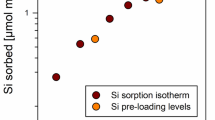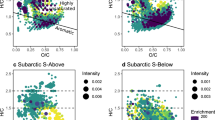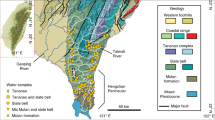Abstract
Silicon has a crucial role in many biogeochemical processes—for example, as a nutrient for marine and terrestrial biota, in buffering soil acidification and in the regulation of atmospheric carbon dioxide. Traditionally, silica fluxes to soil solutions and stream waters are thought to be controlled by the weathering and subsequent dissolution of silicate minerals1,2. Rates of mineral dissolution can be enhanced by biological processes3. But plants also take up considerable quantities of silica from soil solution, which is recycled into the soil from falling litter in a separate soil–plant silica cycle that can be significant in comparison with weathering input and hydrologic output4,5,6,7,8. Here we analyse soil water in basaltic soils across the Hawaiian islands to assess the relative contributions of weathering and biogenic silica cycling by using the distinct signatures of the two processes in germanium/silicon ratios. Our data imply that most of the silica released to Hawaiian stream water has passed through the biogenic silica pool, whereas direct mineral–water reactions account for a smaller fraction of the stream silica flux. We expect that other systems exhibiting strong Si depletion of the mineral soils and/or high Si uptake rates by biomass will also have strong biological control on silica cycling and export.
This is a preview of subscription content, access via your institution
Access options
Subscribe to this journal
Receive 51 print issues and online access
$199.00 per year
only $3.90 per issue
Buy this article
- Purchase on Springer Link
- Instant access to full article PDF
Prices may be subject to local taxes which are calculated during checkout


Similar content being viewed by others
References
Garrels, R. M. in Researches in Geochemistry (ed. Abelson, P. H.) 405–420 (Wiley, New York, 1967)
Drever, J. I. The Geochemistry of Natural Waters (Prentice-Hall, Englewood Cliffs, NJ, USA, 1988)
Moulton, K. L., West, J. & Berner, R. A. Solute flux and mineral mass balance approaches to the quantification of plant effects on silicate weathering. Am. J. Sci. 300, 539–570 (2000)
Lucas, Y., Luizao, F. J., Chauvel, A., Rouiller, J. & Nahon, D. The relation between biological activity of the rain forest and mineral composition. Science 260, 521–523 (1993)
Alexandre, A., Meunier, J.-D., Colin, F. & Koud, J.-M. Plant impact on the biogeochemical cycle of silicon and related weathering processes. Geochim. Cosmochim. Acta 61, 677–682 (1997)
Meunier, J. D., Colin, F. & Alarcon, C. Biogenic silica storage in soils. Geology 27, 835–838 (1999)
Markewitz, D. & Richter, D. D. The bio in aluminum and silicon biogeochemistry. Biogeochemistry 42, 235–252 (1998)
Conley, D. J. Terrestrial ecosystems and the global biogeochemical silica cycle. Global Biogeol. Cycles 16, doi:10.1029/2002GB001894 (2002)
Froelich, P. N. & Andreae, M. O. The marine geochemistry of germanium: ekasilicon. Science 213, 205–207 (1981)
Froelich, P. N., Hambrick, G. A., Andreae, M. O., Mortlock, R. A. & Edmond, J. M. The geochemistry of germanium in natural waters. J. Geophys. Res. 90, 1133–1141 (1985)
Mortlock, R. A. & Froelich, P. N. Continental weathering of germanium: Ge/Si in the global river discharge. Geochim. Cosmochim. Acta 51, 2075–2082 (1987)
Murnane, R. J. & Stallard, R. F. Germanium and silicon in rivers of the Orinoco drainage basin. Nature 344, 749–752 (1990)
Froelich, P. N. et al. River fluxes of dissolved silica to the ocean were higher during the glacials: Ge/Si in diatoms, rivers, and oceans. Paleoceanography 7, 739–768 (1992)
Kurtz, A. C., Derry, L. A. & Chadwick, O. A. Germanium/silicon fractionation in the weathering environment. Geochim. Cosmochim. Acta 66, 1525–1537 (2002)
Kurtz, A. C. & Derry, L. A. in Proc. 11th Int. Symp. Water Rock Interaction (eds Wanty, R. B. & Seal, R. R.) 833–837 (Swets & Zeitlinger, Lisse, The Netherlands, 2004)
Drees, L. R., Wilding, L. P., Smeck, N. E. & Senkayi, A. L. in Minerals in Soil Environments 2nd edn. (eds Dixon, J. B. & Weed, S. B.) 914–974 (Soil Science Soc. Am., Madison, Wisconsin, 1989)
DeArgollo, R. & Schilling, J.-G. Ge–Si and Ga–Al fractionation in Hawaiian volcanic rocks. Geochim. Cosmochim. Acta 42, 623–630 (1978)
Vitousek, P. M. et al. Soil and ecosystem development across the Hawaiian Islands. GSA Today 7, 1–10 (1997)
Chadwick, O. A., Derry, L. A., Vitousek, P. M., Huebert, B. J. & Hedin, L. O. Changing sources of nutrients during four million years of ecosystem development. Nature 397, 491–497 (1999)
Lajtha, K., Jarrell, W. M., Johnson, D. W. & Sollins, P. in Standard Soil Methods for Long-Term Ecological Research (eds Robertson, G. P., Coleman, D. C., Bledsoe, C. S. & Sollins, P.) 166–182 (Oxford Univ. Press, New York, 1999)
Fraysse, F., Pokrovsky, O. S., Schott, J. & Meunier, J. D. Surface properties, solubility and dissolution kinetics of phytoliths from bamboos of Reunion Island. Geochim. Cosmochim. Acta Suppl. (Proc. 14th Ann. Goldschmidt Conf.), A216 (2004).
Kurtz, A. C., Derry, L. A. & Chadwick, O. A. Accretion of Asian dust to Hawaiian soils: isotopic, elemental and mineral mass balances. Geochim. Cosmochim. Acta 65, 1971–1983 (2001)
Hedin, L. O., Vitousek, P. & Matson, P. Nutrient losses over four million years of tropical forest development. Ecology 84, 2231–2255 (2003)
Vitousek, P. M., Gerrish, G., Turner, D. R., Walker, L. R. & Mueller-Dombois, D. Litterfall and nutrient cycling in 4 Hawaiian montane rain-forests. J. Trop. Ecol. 11, 189–203 (1995)
Exley, C., Schneider, C. & Doucet, F. J. The reaction of aluminium with silicic acid in acidic solution: an important mechanism in controlling the biological availability of aluminium? Coord. Chem. Rev. 228, 127–135 (2002)
Meunier, J. D. The role of plants in the terrestrial biogeochemical cycle of Si. Geochim. Cosmochim. Acta Suppl. (Proc. 14th Ann. Goldschmidt Conf.), A411 (2004).
Kelly, E. F., Chadwick, O. A. & Hilinski, T. E. The effect of plants on mineral weathering. Biogeochemistry 42, 21–53 (1998)
Mortlock, R. A. & Froelich, P. N. Determination of germanium by isotope dilution–hydride generation inductively coupled plasma mass spectrometry. Anal. Chem. Acta 332, 277–284 (1996)
Dove, P. M. in Chemical Weathering Rates in Silicate Minerals (eds White, A. F. & Brantley, S. L.) 235–290 (Mineralogical Society of America, Washington DC, 1995)
Bartoli, F. & Wilding, L. P. Dissolution of biogenic opal as a function of its physical and chemical properties. Soil Sci. Soc. Am. J. 44, 873–878 (1980)
Acknowledgements
We thank A. Moore and P. T. Atkins for field and laboratory assistance. This research was supported by grants from the A. W. Mellon Foundation to L.A.D. and O.A.C., and from the N.S.F. to L.A.D., O.A.C. and A.C.K.
Author information
Authors and Affiliations
Corresponding author
Ethics declarations
Competing interests
The authors declare that they have no competing financial interests.
Supplementary information
Supplementary Discussion and Methods
Stream and soil data. (DOC 23 kb)
Supplementary Tables S1-S3
Supplementary Table S1 Ge and Si in Hawaiian streams. Supplementary Table S2 Ge and Si from Hawaiian soil solutions. Supplementary Table S3 Silica content and Ge/Si ratios of phytoliths from Hawaiian study sites. (DOC 74 kb)
Supplementary Figure S1
Ge versus Si for Hawaiian stream data set. (PDF 41 kb)
Supplementary Figure S2
Ge/Si versus 1/Si Si for Hawaiian stream data set. (PDF 43 kb)
Supplementary Figure Legends
Legends to Supplementary Figures S1 and S2. (DOC 20 kb)
Rights and permissions
About this article
Cite this article
Derry, L., Kurtz, A., Ziegler, K. et al. Biological control of terrestrial silica cycling and export fluxes to watersheds. Nature 433, 728–731 (2005). https://doi.org/10.1038/nature03299
Received:
Accepted:
Issue Date:
DOI: https://doi.org/10.1038/nature03299
This article is cited by
-
Contrasting Silicon Dynamics Between Aboveground Vegetation and Soil Along a Secondary Successional Gradient in a Cool-temperate Deciduous Forest
Ecosystems (2023)
-
Optimization of extraction method for quantitative analysis of Si/Al in soil phytoliths
Acta Geochimica (2023)
-
Soil chronosequence derived from landslides on the upper reach of Minjiang River, western China
Journal of Mountain Science (2023)
-
Origin, formation, and transformation of different forms of silica in Xuanwei Formation coal, China, and its’ emerging environmental problem
Environmental Science and Pollution Research (2023)
-
Role of silicon in phytolith-occluded carbon (PhytOC) sequestration
Vegetos (2023)
Comments
By submitting a comment you agree to abide by our Terms and Community Guidelines. If you find something abusive or that does not comply with our terms or guidelines please flag it as inappropriate.



